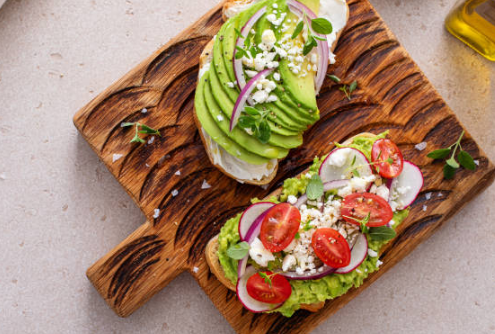Fiber is a powerful nutrient with many benefits, including supporting heart health, aiding digestion, and promoting regularity.
There are two main types of dietary fiber: soluble and insoluble. Soluble fiber dissolves in water and helps stabilize blood sugar and lower cholesterol. Insoluble fiber promotes healthy digestion and bowel regularity. A plant-rich diet can help you meet your daily fiber needs.
1. Eat More Whole Grains
Whole grains—especially those with minimal processing—are loaded with fiber. They can help regulate blood sugar, reduce inflammation, and keep you feeling full longer.
Some fiber-rich whole grains include:
-
Wheat
-
Oats
-
Barley
-
Rice
-
Quinoa
-
Amaranth
-
Corn
-
Buckwheat
2. Bulk Up Baked Goods
Baking something sweet? Try sneaking in some fiber. All-purpose flour is low in fiber because it’s refined and stripped of many nutrients.
Easy ways to boost fiber in baked goods:
-
Add a scoop of oats to cookie dough.
-
Sprinkle oats on top of muffins before baking for added texture and fiber.
-
Mix in a few tablespoons of ground flaxseed to muffin or pancake batter.

3. Add More Fruits and Vegetables
Fruits and veggies are great sources of antioxidants, essential nutrients, and fiber.
Apples and pears are rich in soluble fiber, as are citrus fruits, broccoli, peas, carrots, cucumbers, and celery.
Great insoluble fiber sources include raspberries, pears, apricots, figs, and prunes—famous for keeping digestion on track.
4. Don’t Peel Everything
Eating the skin of certain fruits and vegetables adds extra fiber to your diet.
Apple skins contain pectin, a type of soluble fiber that helps lower LDL (“bad”) cholesterol.
Potato skins are also rich in fiber and iron—so try leaving them on!
5. Snack Smart
Snacks can be a simple way to sneak in fiber. Look for crackers that offer at least 3 grams of fiber per serving, and try to avoid added sugars.
Whole grain crackers, like wheat crisps, often have about 3 grams of fiber per six crackers and little or no added sugar.
Pair fresh fruit with half a cup of Greek yogurt or cottage cheese for a fiber- and protein-rich snack that keeps you full.
6. Add Chia Seeds
Chia seeds are packed with fiber, omega-3s, and antioxidants.
New to chia? Try making chia pudding: soak 2 tablespoons of chia seeds in 1/4 to 1/3 cup of milk overnight. You’ll end up with a snack that delivers around 10 grams of fiber.
Top it with fresh or frozen raspberries for an extra fiber boost.
7. Eat More Nuts and Seeds
Nuts and seeds are a convenient, on-the-go snack full of healthy fats, minerals, and small amounts of fiber.
Nut butters are another great choice. Just 2 tablespoons of natural peanut butter provide about 3 grams of fiber, 8 grams of protein, and key nutrients like vitamin E, magnesium, and calcium.
8. Embrace Legumes
Beans, lentils, and chickpeas are loaded with protein and fiber.
-
½ cup of lentils = ~8 grams fiber
-
⅔ cup peas = ~4 grams fiber
-
½ cup chickpeas = ~4 grams fiber
They’re easy to toss into salads or soups—or simply enjoy with your favorite seasoning.

9. Eat an Avocado
Avocados are rich in heart-healthy monounsaturated fats and delicious in just about anything—from salads to toast to grain bowls.
A medium avocado (about 150g) has around 10 grams of fiber.
Try adding half to a veggie-packed salad or spreading it on whole grain toast. It also pairs well with salmon!
10. Consider Fiber Supplements
Keeping a fiber supplement on hand—like a powder—is a convenient way to fill in gaps when needed.
Psyllium husk, a soluble fiber from the seeds of Plantago ovata, can absorb water in the gut, helping bulk up stool and relieve constipation.
Just remember to drink plenty of water—otherwise, the fiber could swell and cause blockages.
Start with fiber-rich foods, and only use supplements as needed.
Tips for Adding More Fiber to Your Diet
-
Increase fiber gradually to let your body adjust.
-
Keep fresh fruit visible and within easy reach. Store frozen veggies and berries as backups.
-
Blend mild vegetables like cauliflower, cucumber, or zucchini into smoothies for a subtle fiber boost.
More simple swaps to sneak in fiber:
-
Use spelt, oat, or whole barley flour in recipes instead of some all-purpose flour.
-
Add whole corn kernels to cornbread for extra fiber and a hint of sweetness.
-
Try cauliflower pizza crust for a veggie-packed twist.
And don’t forget: Drink more water as you increase your fiber intake—it helps fiber move smoothly through your system.
